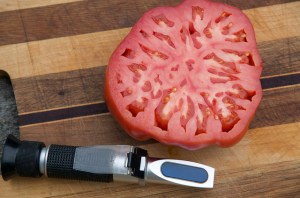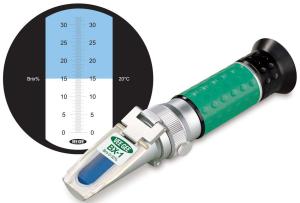Grow High-Quality Nutrient Vegetables … better than Organic
One has to understand that “USDA Organic” is only a certification of a method of growing. It has nothing to do with the quality of the produce grown.
Tomatoes grown entirely with certified organic ingredients and methods can be labeled “100% organic,” while products with at least 95% used organic ingredients may be labeled “organic.”
Now you can test the quality of the produce you purchase from the store or the farmer’s market. The test equipment is portable, and it is possible to try it before you buy it. That might cause some repercussions; we recommend you bring a sample of your Organic Tomatoes to the Sustainable Living Center and get a free High-Quality Nutrient Test.
The world is awash in a sea of misinformation about organic foods. For instance, any Internet search reveals never-ending comments and arguments about “proper diet.” Yet, if you monitor many such discussions, it becomes immediately apparent that the participants, whether physicians, chiropractors, nutritionists, farmers, veterinarians, or laypeople, cannot document what they discuss.
Plants grown with probiotics like bokashi can be shown to have higher mineral density levels using a BRIX meter. Higher mineral density is correlated with plant health and overall flavor. The probiotics help break down the rocks and minerals to deliver humic to the plants. In a synthetic system, plants often cannot absorb all the essential minerals it needs to grow.
Using bokashi gives the plant what it needs to feed a healthy and strong human being. The plant will have, in its soil, everything it needs to live symbiotically with the earth. The bacteria and fungi are equipped with the bokashi, specially formulated to keep the microbes alive and flourishing. The goal is to grow a plant that will provide the essential minerals and flavors to the farmer at the end of the run.
High-Quality Nutrient Testing is easy.
Tomato quality correlates to the number of dissolved solids in plant sap (juice). All you need are the right tools, and you will not be fooled into repurchasing low-quality produce.
The right tool is a refractometer that determines a Brix Value, which indicates the quality of the fruit or vegetable.
A refractometer is an instrument used to obtain a Brix value.
This simple, handheld device measures the amount of refraction (or bend) in a beam of light that passes through the plant sap. It is a portable unit that is handheld and simple to operate.
For more examples of High-Density Food Gardens: Click Here.
To use an optical refractometer
- Squeeze sap out of a plant.
- Put two drops on the prism.
- Close the prism cover.
- Point to a light source.
- Focus on the eyepiece.
- Read the measurement.
When you peer down a long hollow tube at the prism part, the light beam passes through the thin film of plant sap on the prism, while the rest bypasses this specimen. A scale in the viewfinder allows you to identify the Brix value quickly.
The higher the Brix value, the better tasting the sample
What plant part is used?
Whatever part you eat, if it is ripe. If it is not ripe, take the most mature leaves.
The crop with a higher refractive index within a given plant species will have more elevated sugar, mineral, protein, and a greater specific gravity or density.
This adds to sweeter tasting, nutritious food with lower nitrate and water content, lower freezing point, and better storage attributes.
When testing Tomatoes, these are the valves you may get:
Poor = 4 Average = 6
Good = 8 Excellent = 12+
Green Bean Testing
Two (2) samples of fresh green beans were analyzed by a refractometer and a professional, scientific lab.
Beans Purchased at the Store
When 100 grams (about 3 ½ oz.) were analyzed in a professional, scientific lab.
It was found to be nearly the same as the USDA average, and the Brix value was 4.2
| Nutrient | USDA | Store |
| Protein | 1.8 g | 1.76 g |
| Calcium | 37 mg | 70 mg |
| Magnesium | 25 mg | 30 mg |
| Phosphorous | 38 mg | 40 mg |
| Potassium | 209 mg | 190 mg |
| Copper | 0.1 mg | 0.1 mg |
| Iron | 1.0 mg | 1.3 mg |
| Zinc | 0.2 mg | 0.72 mg |
| Manganese | 0.2 mg | 0.29 mg |
|
| |||||||||
The quality of the soil causes higher Brix values. The highest for Beans is 10+
Beans Grown in the Garden
It was found to be nearly 2-3 times that of the USDA average, and the Brix value was 6.1
| Nutrient | USDA | Garden |
| Protein | 1.8 g | 3.34 g |
| Calcium | 37 mg | 130 mg |
| Magnesium | 25 mg | 50 mg |
| Phosphorous | 38 mg | 80 mg |
| Potassium | 209 mg | 580 mg |
| Copper | 0.1 mg | 0.4 mg |
| Iron | 1.0 mg | 2.1 mg |
| Zinc | 0.2 mg | 2.3 mg |
| Manganese | 0.2 mg | 0.35 mg |
|
| |||||||||
Free High-Quality Nutrient Testing is given at the Sustainable Living Center at scheduled times. Call 541-996-3671 for the following available test dates.
The Sustainable Living Center is located at 82 Siletz Highway, Lincoln City, OR 97360.
What are the Nutrients Value of your Organic Tomatoes?
|
| ||||||||||






You must be logged in to post a comment.